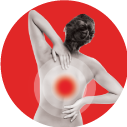
The explicit tangy zip of ginger lies on top of the shelf in the spice cabinet. And why not? Besides being a savory ginger spice, ginger for arthritis and pain relief has been a remedy for generations. It soothes pain and joint inflammation.
Over the years, it has served faithfully as traditional medicine and has been consumed in the form of teas, tinctures, ginger powder, food, and oil. As time passed, ginger capsules took a finite form. Applying a gel or cream containing ginger straight away to the affected area provides succor.
The benefits of ginger oil for pain have been known to improve osteoarthritis in knees and relieve pain in rheumatoid conditions. After a muscle injury ginger extract has been profoundly found to be a great substitute for non-steroidal, anti-inflammatory drugs (NSAIDs).
1. Reduces Joint Inflammation
Inflammation is a buzzword that we come across a lot of times. It sounds like an alarming bell for alerting the body to get fixed from its stressful condition. The exclusive aspect of joint pain and various proinflammatory molecules initiate the development of this severity. Ginger has an active component called gingerol that suppresses the synthesis of such molecules and helps to treat rheumatoid arthritis by reducing the inflammation of joints. Regular intake of ginger for joint pain helps in preventing the onset of arthritis.
2. Osteoarthritis Therapy
Osteoarthritis is a degenerative joint disease in which the cartilage breaks down erratically, causing pain, swelling, and difficulty in moving the joints. It is a chronic disease in which, if the conditions worsen, then bones may also break down. Ginger for arthritis pain relief has been the treatment of osteoarthritis. It also safely potentiates the impact of painkillers. The oral ginger treatment or the topical application in osteoarthritis leads to a significant reduction in pain and disability. Also, ginger for arthritis has been included in herbal preparations, which are effective as traditional treatments in improvising osteoarthritis symptoms.
3. Antioxidant Power Of Ginger
When the body is battling with sinners like free radicals, it is under tremendous stress. The antioxidant activity of ginger shuts down the hit of this oxidative stress, which otherwise would create adverse effects by making the conditions of rheumatoid arthritis more painful. There is an overproduction of reactive oxygen species leading to debilitating damage and insufficiency of antioxidant defense in such patients. Gingerol and shogaol fractions are potent antioxidant components of ginger and, importantly, have radical scavenging action. Therefore ginger for painful joints is an elixir and a powerful remedy.
4. Arthritis Relief
Arthritic pain can pull the rug right out from under life. Pain and inflammation are the inevitable consequences of this disease that usher significant lifestyle changes. Ginger for inflammation and pain itself is an excellent asset for achieving relief during arthritis as it blocks the calcium channel involved in the generation of nociceptive signals, which cause pain generated by the neurological signaling.
The benefits of ginger, along with Indian Frankincense, are found in one of the best joint health supplements called FlexiQule, which can effectively reduce pain and joint stiffness. Having 2-3 tablets in a day can give significant relief from pain.
5. Protects From Rheumatoid Arthritis Complications
Ginger has an overall effect of ginger extracts on the severity of rheumatoid arthritis, which leads to plenty of complications in the body, including the joints and bones. With its anti-inflammatory and antioxidant properties, it provides relief from this dreadful debilitating condition. The benefits of ginger can be obtained from fresh, dried, pickled forms.
The article is based on the information available in public and which the author believes to be true. The author is not disseminating any information which the author believes or knows is confidential or in conflict with the privacy of any person. The views expressed or information supplied through this article is mere opinion and observation of the author. The author does not intend to defame, insult or cause loss or damage to anyone, in any manner, through this article.




































